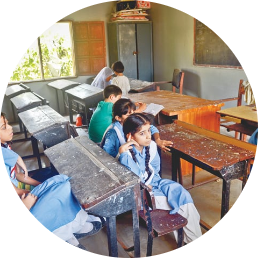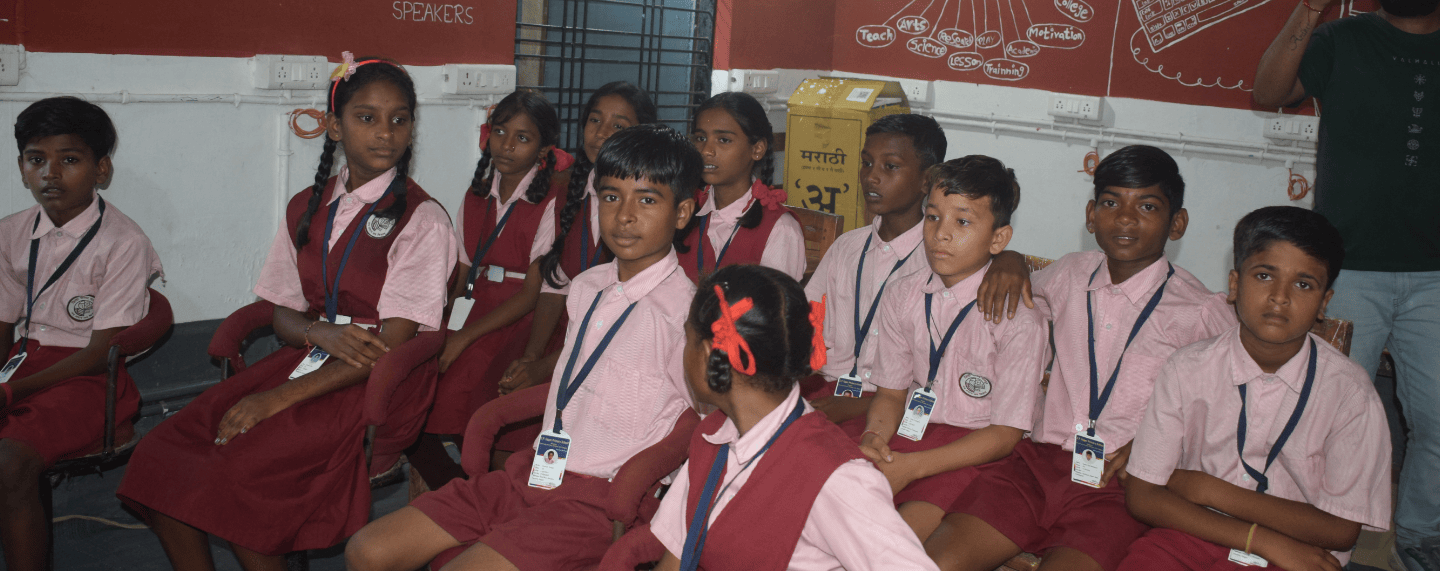
Amrit Gram Project prioritized education as a critical intervention. This intervention recognizes education as a powerful catalyst for empowering communities, driving economic growth, and fostering sustainable development. By enhancing educational access, quality, and relevance, the project seeks to transform the socio-economic landscape of rural areas.
Currently, In the education sector, Amrit Gram is working on the following:
Implementing advanced technologies like AR, VR, and tablets can revolutionize rural Indian education by enhancing learning experiences and addressing resource constraints.

The absence of digital classrooms in rural India introduces a multitude of impediments for both students and educators. Here’s a look at the key issues:

The absence of digital classrooms deprives rural students of the advanced learning possibilities that educational technology offers, such as interactive learning materials, multimedia resources, and online platforms. This can result in a less immersive and dynamic learning experience. According to the National Sample Survey (NSS) 75th Round, only about 8% of rural households in India have a computer, limiting students’ exposure to digital learning tools.

The digital divide between rural and urban students is intensified by the lack of digital classrooms. Urban schools equipped with digital resources can potentially offer a more holistic and contemporary education, thereby widening the educational disparity with rural counterparts. As per the UNESCO Institute for Statistics, in 2019, the Internet usage rate was 47% in urban areas compared to just 14% in rural regions in India.

The effectiveness of digital education is contingent on teachers’ technological familiarity and their ability to integrate digital tools into their teaching methods. However, many rural area educators may lack this familiarity or the necessary training. The Annual Status of Education Report (ASER) 2020 reveals that only 38.2% of rural teachers received any form of online training.

Infrastructure constraints, such as inconsistent electricity supply and poor internet connectivity, are prevalent in rural areas. These challenges can make the implementation of digital classrooms impractical or even impossible. According to the India Internet 2019 report by IAMAI-Nielsen, only 25% of rural Indians have access to the internet.

The establishment of digital classrooms requires investment in hardware, software, and internet connectivity. For resource-strapped rural communities, the cost of setting up and maintaining digital classrooms can present a significant hurdle. The World Bank estimates that the cost of providing digital access to all of India’s rural schools could reach up to $6 billion, a substantial investment for many communities.

The incorporation of advanced technologies like Augmented Reality (AR), Virtual Reality (VR), and tablets can revolutionize the digital classroom experience for rural Indian students. Here’s how this can be achieved:

The successful implementation of AR, VR, and tablet-based digital classrooms necessitates robust infrastructure. This includes ensuring reliable electricity supply and stable internet connectivity in rural areas. The Indian government’s Pradhan Mantri Sahaj Bijli Har Ghar Yojana (Saubhagya) scheme, targeting universal household electrification, could be a promising step in this direction.
Addressing the issue of limited or unstable internet connectivity in rural areas is crucial. This can be done by investing in improved network coverage and exploring affordable internet solutions. Additionally, the availability of offline modes for content delivery on tablets can help overcome connectivity issues, ensuring uninterrupted access to educational materials.
To maximize the potential of AR, VR, and tablets in education, teachers need comprehensive training programs. These should not only equip educators with the necessary technical skills but also introduce innovative pedagogical approaches. According to the National Council for Teacher Education (NCTE), teacher training can increase the effectiveness of technology use in the classroom by up to 70%.
To ensure that students can understand and engage with digital resources, it’s essential to develop educational content in local languages and culturally relevant contexts. This strategy can enhance the learning experience and improve students’ information retention rates. A study by the British Council suggests that instruction in the mother tongue can improve learning outcomes by up to 27%.


The integration of digital classrooms and the incorporation of Augmented Reality (AR) and Virtual Reality (VR) technologies in rural Indian schools can bring about a paradigm shift with numerous positive effects on students, teachers, and the broader education system. Here are some key impacts:
The interactive and immersive nature of digital classrooms, AR, and VR technologies can significantly enhance the learning experience. These technologies allow rural students to interact with content through simulations and 3D visualizations, making challenging concepts more accessible and easier to retain. According to the Stanford University Virtual Human Interaction Lab, VR can improve learning retention rates by up to 33%.
By harnessing the power of technology, rural schools can tap into a vast reservoir of educational resources, such as e-books, online courses, and educational apps. This technological infusion can help narrow the educational chasm between rural and urban areas, offering rural students a more level playing field.
Digital classrooms foster personalized learning, empowering teachers to tailor educational content to the individual needs and learning pace of each student. This approach nurtures more meaningful teacher-student interaction and allows for a more nuanced focus on students’ strengths and weaknesses. The Gates Foundation reports that personalized learning can boost student achievement by 5-10%.
The advent of digital classrooms reduces reliance on physical textbooks and printed materials, which might be in short supply in rural areas. Tablets and e-learning devices can store a wide array of educational content, making resources readily available to students irrespective of their geographical location.
The implementation of AR and VR technologies in rural schools offers students first hand exposure to advanced technology. This exposure can provide rural students with a preview of the digital competencies required in today’s modern workforce, preparing them for future professional opportunities
providing a comfortable atmosphere, enhancing learning, improving attendance, promoting health and well-being, and reducing greenhouse gas emissions. Implementing solar AC classrooms can lead to a 15% improvement in student performance and a 60% increase in engagement among the younger generation.

The absence of air-conditioned rooms in rural Indian schools, coupled with extreme heat conditions, poses several challenges for students. Here are some significant issues:

The high temperatures and humidity in non-AC classrooms can lead to significant physical discomfort and heat stress among students. This stress can cause fatigue, decreased concentration, and difficulties in focusing on academic tasks. According to a study published in Nature Human Behaviour in 2018, students’ cognitive performance decreases by 13% for every 1-degree rise in temperature.

The uncomfortable learning environment can adversely affect students’ cognitive functions and overall learning performance. It may result in shortened attention spans, impaired memory retention, and diminished academic achievement. A Harvard study found that students who learned in non-AC classrooms during a heatwave scored nearly 13% lower on a series of cognitive tests compared to those in air-conditioned rooms.

Students exposed to extreme heat without proper ventilation may suffer from health issues like dehydration, heat exhaustion, and heatstroke. These conditions pose significant risks to students’ well-being and school attendance. According to the Indian Journal of Occupational and Environmental Medicine, around 20% of heat-related illness cases in India occur in children.

During intense heatwaves, students may be more likely to be absent from school due to health concerns or their parents’ apprehension about sending them to school under such harsh conditions. A study by the Institute for Social and Economic Change (ISEC) reports that heatwaves can cause school absenteeism rates to increase by up to 30%.

The introduction of solar air-conditioned (AC) classrooms can bring about substantial improvements in rural schools grappling with severe heat conditions. Here are the key advantages:
Solar AC classrooms create a comfortable and cool atmosphere, effectively mitigating heat stress and discomfort among students. The resultant improvement in students’ focus and concentration can significantly bolster learning outcomes. Research conducted by the National Bureau of Economic Research highlights that a comfortable classroom temperature can increase a student’s learning ability by up to 12%.
By offering a more comfortable learning environment, solar AC classrooms can motivate students to maintain regular school attendance, even during periods of intense heat. Improved attendance facilitates continuity in learning and promotes steady academic progress. A study by the World Bank suggests that a 10% increase in school attendance can lead to a 0.3% rise in student performance.
Solar AC classrooms can help prevent heat-related health issues like heat exhaustion and heatstroke. This protection not only safeguards students’ health but also enhances the overall well-being of both students and teachers. According to the Centers for Disease Control and Prevention (CDC), air-conditioned environments can reduce the risk of heat-related illnesses by as much as 80%.


The introduction of solar air-conditioned (AC) classrooms in rural schools in India can be a game-changer, offering numerous advantages to students, teachers, and the overall educational climate. Here are some key benefits:
Solar AC classrooms contribute to environmental sustainability by significantly reducing greenhouse gas emissions. By harnessing renewable solar energy, these classrooms help minimize the school’s carbon footprint, aligning with global initiatives to combat climate change. According to the International Energy Agency, solar power can reduce CO2 emissions by up to 600 grams per kilowatt-hour, compared to traditional electricity generation methods.
The implementation of solar AC classrooms often necessitates community involvement and support, engendering a sense of ownership and pride among community members regarding the school’s evolution and progress. As per a UNICEF report, community engagement in school development can lead to a 15% improvement in student performance.
The integration of solar technology in classrooms provides an invaluable opportunity to educate students about renewable energy sources and their significance for a sustainable future. This exposure can help raise awareness and encourage eco-friendly practices among the younger generation. A study in the Journal of Environmental Education shows that practical learning about renewable energy can increase students’ engagement by up to 60%.
We believe that together, we can make a real impact. Join us today and take a step towards building a better tomorrow!

Rite Water is excited to introduce Amrit Gram™, a ground-breaking concept aimed at creating self-sufficient, self-sustaining, and future-ready model villages in India, to the recipient. This initiative is aligned with the vision of the Honorable Prime Minister of India, Shri Narendra Modi, for a utopian golden period in India called “Amrit Kaal.”
© 2023 Amrit Gram. All rights reserved.